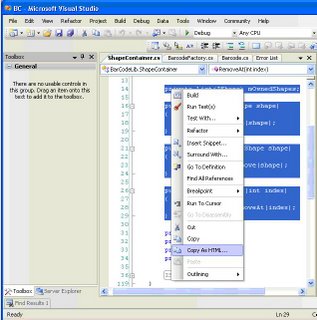NHibernate handles loading/saving objects to RDBMS via it's own implementation of session object. Until now, I'm familiar with 3 ways for handling NHibernate sessions:
- create session per each database operation - session is created before and destroyed after each operation with database. This is very ineffective way, because some features like lazy loading are unavailable. Also including several database operations in transaction is impossible.
- create session per each request - session is created before and destroyed after each HTTP request. This is my favorite strategy, because it is effective and very easy for implementation. I'll give example for possible implementation in this post.
- create session per each application transaction - session is created before and destroyed after each application transaction. Example for application transaction is adding invoice with invoice items.
So, lets begin with the implementation of session per request strategy. If you are reading this post you are most likely a developer and probably as most developers prefer to read source code instead of boring documentation. So I'll explain all of the classes in brief and will post full source code. First I'll declare a base abstract class for all of the session strategies.
public abstract class OrmManager
{ public OrmManager() {}
static NHibernate.Cfg.Configuration mConfiguration = null;
static volatile ISessionFactory mSessionFactory = null;
static object mFactorySyncObject = new object();
public abstract ISession session
{ get;}
public IDbConnection sessionConnection
{get { return session.Connection; }
}
public ISession NewSession()
{ ISessionFactory sessionFactory = GetSessionFactory(); return sessionFactory.OpenSession();}
public abstract bool isActiveSession
{ get;}
public abstract void closeSession();
private const string HBM_ASSEMBLY_NAME_SECTION = "HbmAssemblyName";
private ISessionFactory GetSessionFactory()
{if (mSessionFactory == null)
{ lock (mFactorySyncObject) {if (mSessionFactory == null)
{ string hbmAssemblyName = ConfigurationManager.AppSettings[HBM_ASSEMBLY_NAME_SECTION];mConfiguration = new NHibernate.Cfg.Configuration();
mConfiguration.AddAssembly(hbmAssemblyName);
mSessionFactory = mConfiguration.BuildSessionFactory();
}
}
}
return mSessionFactory;}
public void BeginTransaction(IsolationLevel isolation)
{session.BeginTransaction(isolation);
}
public void CommitTransaction()
{session.Transaction.Commit();
}
public void RollbackTransaction()
{session.Transaction.Rollback();
}
public bool isActiveTransaction
{ get {return ((session.Transaction != null) &&
(!session.Transaction.WasCommitted) &&
(!session.Transaction.WasRolledBack));
}
}
}
Next, I'll implement the class responsible for session per request management. The following class implements IHttpModule so, we can handle end of the request and close any open sessions.
public class PerRequestWebManager : OrmManager, IHttpModule
{ public PerRequestWebManager() {}
private const string NHIBERNATE_SESSION_KEY = "NHIBERNATE_SESSION";
public override ISession session
{ get { ISession resultSession;if (HttpContext.Current.Items.Contains(NHIBERNATE_SESSION_KEY))
{resultSession =
(ISession)HttpContext.Current.Items[NHIBERNATE_SESSION_KEY];
}
else {resultSession = NewSession();
HttpContext.Current.Items[NHIBERNATE_SESSION_KEY] = resultSession;}
return resultSession;}
}
public override bool isActiveSession
{get { return HttpContext.Current.Items.Contains(NHIBERNATE_SESSION_KEY); }
}
public override void closeSession()
{if (isActiveSession == true)
{if (isActiveTransaction == true)
{RollbackTransaction();
}
session.Close();
HttpContext.Current.Items.Remove(NHIBERNATE_SESSION_KEY);}
}
#region IHttpModulepublic void Init(HttpApplication context)
{context.EndRequest += new EventHandler(OnEndRequest);
}
public void Dispose()
{ //Intentionaly not implemented}
public void OnEndRequest(Object sender, EventArgs e)
{closeSession();
}
#endregion}
Now I'll make one generic DAO class with the help of previos PerRequestWebManager.
public class GenericDAO<T>
{ public GenericDAO() { orm = OrmManagerFactory.GetInstance();}
private OrmManager orm;
public T Load(object id)
{return (T) orm.session.Load(typeof(T), id);
}
public void Save(T entity)
{ bool manageTransaction = ! orm.isActiveTransaction; if (manageTransaction) { orm.BeginTransaction(IsolationLevel.ReadCommitted);}
try {orm.session.SaveOrUpdate(entity);
if (manageTransaction) {orm.CommitTransaction();
}
}catch(Exception e)
{ if (manageTransaction) {orm.RollbackTransaction();
}
throw e;}
}
}
public class OrmManagerFactory
{ private OrmManagerFactory() {}
private const string ORM_MANAGER_TYPE_SECTION = "OrmManager";
public static OrmManager GetInstance()
{string ormType = ConfigurationManager.AppSettings[ORM_MANAGER_TYPE_SECTION];
if (ormType == typeof(PerRequestWebManager).Name)
{return new PerRequestWebManager();
}
else {throw new Exception("Unknown ORM manager type");
}
}
}
And here's how all of the above can be used in ASP.NET application:
GenericDAO<Article> articleDao = new GenericDAO<Article>();
Article article = articleDao.Load(1);article.Name = "Paracetamol";article.SalePrice = rnd.NextDouble();
articleDao.Save(article);
If you are interested I can mail you full source of this post. Enjoy!

